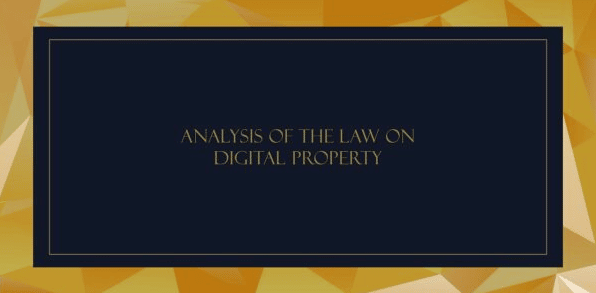What is Law of Property?

Digital property, also digital assets, is any information created by you or about you that exists in a digital form. The information can be stored on an electronic device or online, including the information that one needs to access the digital property. Many digital properties put together make up a digital estate.
NFTs (Non-Fungible Tokens) are good examples of digital assets. They are digital assets that run on the blockchain. The blockchain is a public ledger of records and it is the same technology that powers cryptocurrencies such as Bitcoin and Ethereum. Digital property NFT represents the ownership of real-world objects such as pieces of art. Each NFT is unique and can only have one official owner at a time. This is made possible by the fact that NFTs cannot be duplicated or reproduced. This has made NFTs a common way of representing assets. They are created, bought, and sold on NFT marketplaces such as OpenSea, Foundation, Rarible, and SuperRare.
Types of Digital Property

Today, there are different types of digital property. The following are some of the common types of digital assets:
#1: Images
Images are good examples of digital assets and they can be in different formats such as PNG, JPEG, GIFs, and others. JPEGs are smaller in size and are mostly used in email campaigns and web pages. PNGs are a bit larger and have transparent backgrounds, making them good for use in social media posts and custom graphics. GIFs are graphics reduced to 256 colors to create short videos that can be loaded quickly.
#2: Videos
Videos are types of digital assets and they can also be in various formats. Some of the common video file formats include .mp4, .mov, and avi, and these have their substandard formats.
MP4s are a common way of sharing video digital assets on the web and .avi files are known to retain more value than MP4 files. These files can be turned into digital property NFT.
#3: Audio files
Audio files come third in our list of types of digital property. Companies use them to further their stories. Some of the common uncompressed audio file formats include MP3, AU, WAV, and others. MP3s are preferred because of their compressed size. These files are governed under the law of digital property and can be sold as digital property NFT.
#4: Graphics
These digital assets can be anything from branding materials to logos and are governed under the law of digital property. If designers are working with your team, they will be dealing with various types of graphic files.
What does Digital Law mean?

Digital law is the type of law that governs the ownership and use of digital assets. It deals with the legal and regulatory considerations for digital assets. Most digital assets are protected by copyright law. This law deals with recorded or written digital assets.
It’s worth noting that copyright is an automatic right, meaning that you are not required to register the ownership of your digital assets such as digital property NFT. The law of digital property gives copyright protection to the first owner or the creator of the digital asset.
However, sometimes it can be difficult to prove the ownership of digital assets. To show that you are the original owner of a particular digital asset, you can use the copyright symbol © or add a declaration that states so. You can make a comprehensive statement like “All rights are reserved. This work should not be reproduced, reprinted, or used without the written permission of the publisher.”
Digital assets such as digital property NFT should not be seen as a way to separate or oppose the law of digital property, but as a way to minimize the need for the law to intervene. For example, digital artists are finding it easy to prove the ownership of their artwork by the use of digital property NFT than with traditional printed art.
Some digital assets can be protected digitally through encoding, watermarking, or encryption. Such methods prevent the unauthorized use of digital assets such as intellectual property NFT, music, software, photographs, and others.
Some digital asset protections are meant for the “copy once-use many” approach. This means that the asset can for example be downloaded once but used freely. This is usually the case with digital property NFT. Although online users are free to use the asset represented by the NFT, there is only one official owner for that NFT.
According to the law of digital property, the use of a digital asset without permission amounts to a breach of copyright. In some circumstances, copying digital assets amounts to a criminal offense. Thus, breaking the encryption placed on digital assets can be punishable.
